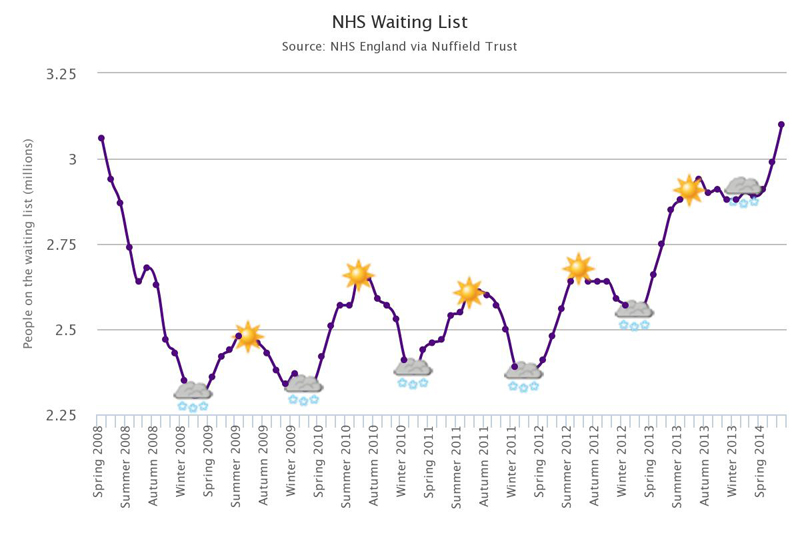I'd heard over the weekend that Jeremy Hunt would make an announcement on NHS waiting times today. My sort of thing (see Buzzfeed for details). I was intrigued.
When I got up, I read this short teaser piece from the Health Service Journal. In a nutshell, Mr. Hunt was giving trusts space to treat people who'd been waiting the longest by allowing them to breach overall targets. I was still half asleep but this was good news – for people who need treatment, waiting a long time is a real problem.
The idea is, if you relax the 18-week target – which is that 90 per cent of people should be treated within 18 weeks of referral – you remove the incentive to focus on treating people coming up to the 18-week breach and deal with those waiting a lot longer. That's worth doing because, although ideally nobody should wait past 18 weeks, once people have waited that long they deserve to be prioritised – and relaxing the target means trusts aren't penalized for treating them.
Walking to the bus stop gave my brain time to wake up and focus. Unfortunately, the number cruncher in me was getting suspicious. While the idea to give trusts space to treat people is a noble one, the timescales suggest that more basic, electoral concerns might be at stake. Let's break this down.
Things have been going south for a while on all measures of how long people wait for treatment. The length of time people wait for treatment has been on the rise, the waiting list has been getting longer, and the measure that gets the headlines – people waiting more than 18 weeks for their treatment – has also been on the rise.

NHS Waiting Time.
For those who aren't so interested in waiting times data, let me explain the trend as it's a bit odd. The number of people on the waiting list has a strong seasonal trend. More people wait in the summer and fewer in the winter. As the overall volume follows this trend so does the number of people who have waited less than 18 weeks for treatment.
This means that, in terms of the 18-week target, things are always more challenging over the summer. We would expect the figures due out this Thursday to show the target being missed, and the same will go for a few months to come. Now, instead of being blamed for the inevitable breaches, Mr. Hunt has claimed them for his own. They’re all part of a big, positive plan.
And although he has also taken the usually risky move of promising to turn things around by the end of the year, this seasonal effect makes that a safer bet than it sounds. It is likely the waiting list will shrink again in the winter – it usually does. Relaxing the target until things cool down creates room to manoeuvre not just for hospital managers, but for Whitehall and Westminster too.
Forgive my scepticism, but what happens next summer if the list grows again? By then, the next reshuffling of power has happened and waiting times are old news. While it is completely unacceptable that people wait more than a year for treatment, is putting all your ambitions into the longest waiters the right problem to tackle here? We need to bear in mind that the number waiting this long is less than one in five thousand of the people on the list. Making things better for those nearer to the average holds out the chance to help far more patients get treatment sooner.
Mr. Hunt states that targets in isolation can be dangerous. That’s true where they distort behaviour, but dropping them when they are pushing up performance carries its own risks. Relaxing a target gives it less clout in hospital boardrooms, and could lead to a longer term reduction in performance. That might sound like a cynical take on what makes the NHS work, but there's a clear precedent in the step down in A&E waiting times we saw when targets were lowered in early 2010.
The problem here is much bigger. We need to prepare a long term solution not a short term fix. Focusing on the small number of people waiting the longest distracts from the growing number of new people joining the list and those already waiting longer and longer. The pattern of more and more people needing treatment from a severely limited budget isn't going to go away by Christmas, or even at David Dimbleby's bedtime on Election Night. It will be with us for years, and decades, to come.
Suggested citation
Dorning H (2014) ‘A good idea? Wait and see’. Nuffield Trust comment, 4 August 2014. https://www.nuffieldtrust.org.uk/news-item/a-good-idea-wait-and-see
